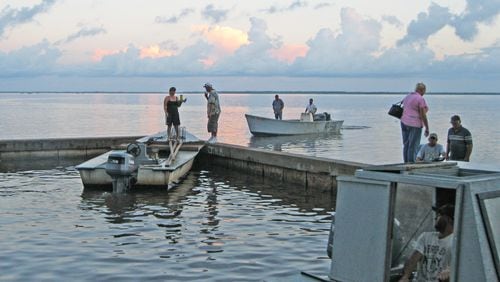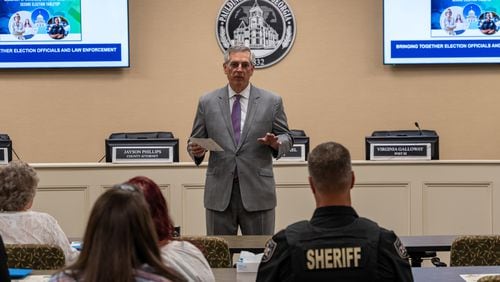The 2010 Deepwater Horizon disaster threatened to spread oil from Texas to Florida and kill every shrimp, snapper and oyster in the Gulf of Mexico. Oystermen in Florida freaked out and, joined by fishermen from as far away as Texas, scraped every possible oyster — legal-sized or not — from the bottom of Apalachicola Bay.
The still-poor condition of the bay and the oyster industry serves as the crux of the water war trial underway in this coastal New England town. Ralph Lancaster Jr., the special master assigned by the U.S. Supreme Court to remedy the 27-year-old interstate dispute, will ultimately decide who is to blame for the industry’s collapse.
The trial’s first week ended Friday with a detailed examination of oyster fishing and Florida’s role in allowing the long-term degradation of the industry. It resumes Monday with the same focus.
Florida says a lack of freshwater coming down the Apalachicola River from Georgia is to blame for the bay’s poor health. Georgia counters that over-fishing and lax management of oystering rules caused the damage.
Few dispute how much the industry suffered. Nearly 500 oystermen routinely fished the bay five years ago. Today, maybe 100 do. Oyster catches are down at least 75 percent since the Deepwater disaster. Fishermen can’t fill more than four bags daily. Sales last year didn’t reach $5 million.
Florida points fingers at Georgia for not allowing enough water from the Chattahoochee or Flint Rivers, or various aquifers and streams, to reach the Apalachicola River and, ultimately, the bay. Oysters need a healthy mix of fresh and salt water to thrive.
The U.S. Army Corps of Engineers controls the amount of water flowing into Florida from the Jim Woodruff Dam that straddles the border. While it guarantees a minimum flow during times of drought, the amounts aren’t always sufficient for oysters. During the September 2012 drought, for example, the corps discharged about a fourth as much water into Florida as it had three years earlier when Georgia’s rivers were high.”
“It is clear that the salinity and environmental conditions in the bay were primarily due to low flows which caused dramatic declines in oyster reefs as well as the fish, the crabs and the shrimp that followed the 2011 and 2012 drought,” said Dan Tonsmeire, the Apalachicola Riverkeeper who’s attending the trial.
Georgia disagrees and unveiled ample evidence this week to place blame on Florida.
Florida environmental officials, soon after the Deepwater disaster, extended the oystering season in the bay. More oyster bars, or reefs, were opened to fishing. Enforcement of size regulations — no oyster smaller than 3” is to be harvested — was lax.
“There was a use-it-or-lose-it approach (to fishing),” Mark Berrigan, the state of Florida’s top oyster scientist, testified Friday. “Under the circumstances it was not an unprudent decision to allow oystermen to remove these stocks that it looked like we were goiong to lose. It was almost like leaving fruit on the vine.”
He added, “(In) the years following, the same attitude existed and continued.”
The University of Florida reported in April 2012 that “insufficient fishery management enforcement” was also to blame. Even Gov. Rick Scott said that year that “over-harvesting of illegal and sub-legal oysters (is) further damaging an already stressed population.”
Bad conditions persisted until late 2012 when it started raining again upstream. Gov., Scott had by then asked for, and received, a disaster declaration for the Apalachicola Bay from Washington which allowed oystermen to apply for government assistance. He sued a year later blaming Georgia’s “unchecked and growing consumption of water” for the bay’s collapse.
Florida wants Judge Lancaster to impose a cap on Georgia’s water consumption and boost, by as much as 40 percent, the amount of water flowing into the Apalachicola River. Meanwhile, the oyster industry suffers.
“In the past, the oyster populations were resilient so we were able to fish them hard and the populations came back,” Berrigan, the Florida scientist, told Apalachicola officials and fishermen in a 2012 video introduced as trial evidence. “In this case we probably bent too far. We bent until we broke. Things are going to have to change.”







